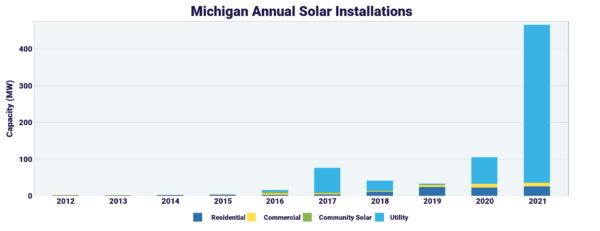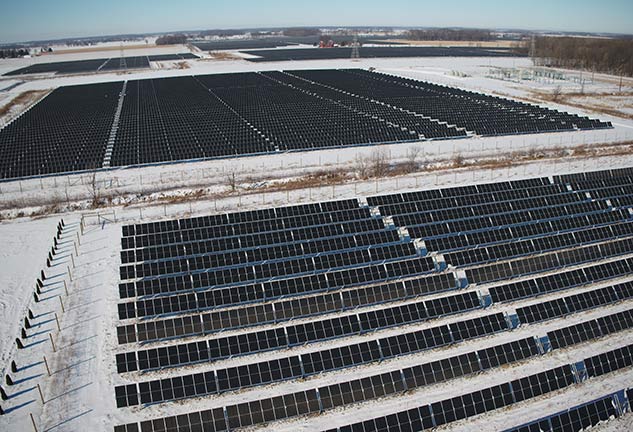The pv magazine USA tour of solar incentives last stop was Texas, and now jumps north to Michigan.
Michigan, the Great Lakes State, is located in the upper Midwest and ranks 10th largest by population and 11th by area. It is known as the center of U.S. automotive manufacturing, with three major automobile companies headquartered in the Detroit area.
Last Spring, Michigan’s Governor Gretchen Whitmer announced the Michigan Healthy Climate Plan, which proposes that the state gets to 60% renewable energy resources and build infrastructure to accommodate millions of electric vehicles by 2030. The plan has been under development since 2020 when the Governor committed Michigan to achieving economy-wide carbon neutrality by 2050. This included interim reductions of 28% by 2025, 52% by 2030, and maintaining net negative greenhouse gas emissions after 2050.
The Governor has begun taking steps outlined in the plan. She committed to powering all state facilities with 100% renewable energy by 2025 and attracted battery and electric vehicle manufacturing investments from automakers, who have added 21,600 jobs in the state.
While the roadmap put the state near the top in renewable expectations, it is currently planted squarely in the middle as far as how much solar is installed. According to the Solar Energy Industries Association (SEIA), in 2022 Michigan ranked 25th with just under 1 GW installed, or enough to power 153,000 homes. SEIA projects that the state will install another 2.4 GW over the next five years.

Incentives
Michigan’s renewable portfolio standard (RPS) states that 15% of the state’s energy consumption must be from renewable sources.
Net metering ended in the state in 2018, replaced by the “Distributed Generation Program.” This program is similar to net metering because solar users get credit for all the excess energy they send to the grid—but only during the day. The credits vary by utility and are used to offset the power supply portion of their electric bills.
“Michigan EIBC and our member companies have been working for years to address the challenges facing customer-sited distributed energy resources, like rooftop solar and storage, as well as community solar projects in Michigan,” said Dr. Laura Sherman, president of the Michigan Energy Innovation Business Council. “For rooftop solar, one of the biggest challenges is the limit on how much solar can be installed by homeowners and businesses and the limit on how big those solar projects can be.”
Such a limit creates a challenge to any customer thinking about going solar, because they can’t be sure they’ll be able to benefit from net metering. It also presents an obstacle to solar installers who, because of the uncertainty, are cautious about hiring new employees or expanding their businesses.
“We’re working with the legislature to reintroduce bills to eliminate the limits on rooftop solar and ensure that customers are fairly compensated for benefits they provide to the grid,” said Sherman.
Consumers Energy, an investor-owned utility serving over 6 million customers in Michigan, had set a cap of 2% total distributed generation in its territory, which was one of the most restrictive distributed energy ratemaking rules in the nation and had come under fire from solar advocates and environmentalists. In December the utility filed a settlement agreement with the Michigan Public Service Commission (MPSC) in its 2022 rate case, agreeing to double the cap from 2% to 4%. The utility now awaits MPSC’s approval on the settlement agreement.
Community solar
Community solar enables those who cannot afford solar on their own homes, or whose homes are not amenable to solar, to benefit from renewable energy. Unfortunately Michigan does not have any community solar legislation in place.
Last year House Bills 4715 and 4716 were presented to the legislature, which—if passed—would allow for the creation and financing of community solar facilities and for subscribers to receive credit for solar produced. The bills would also include mechanisms to ensure that low-income households or service organizations could subscribe to community solar and called for the development of financing options, financial incentives, education and outreach programs. The bills never reached a vote in the last session, but will be reintroduced in the new legislative session in the House and Senate in the coming weeks.
“Here at CCSA, our goal is to pass the legislation, cut red tape, and enable the creation of a community solar program that will give access to customers across Michigan,” said Carlo Cavallaro, Midwest Regional Director of the Coalition of Community Solar Access. “Without legislation passing, customers will not be able to access community solar.”
Michigan EIBC also sees the value in community solar. “It’s important that these projects are driven by communities and generate the greatest benefit to those communities,” said Sherman. “Michigan EIBC is working with partners to reintroduce legislation that would create a legal structure for community solar projects and ensure all Michiganders are able to access the benefits of renewable energy.”
Solar loans
Michigan Saves is a non-profit green bank that offers low-interest loans to homeowners or businesses that want to go solar or go all electric. The program has set a goal to provide $1 billion in clean energy finance by the end of this year, and that includes supporting low- to middle-income individuals.
Cutting rate increase
Last February, Michigan electric utility DTE Energy proposed to implement new charges for future residential solar customers that dissuade people from going solar. But in a win for rooftop solar, the Michigan Public Service Commission announced that it had rejected the plan. This came as part of a November 2022 ruling that rejected the utility’s proposal for a $388 million rate increase, instead approving a $30.5 million increase. The full ruling can be found here.
Landmark installations
The Assembly solar project is the largest solar installation to date in the state of Michigan. Built in three phases, the third and final phase came online early last year. The 346.9 MWdc solar installation spans a total of 1,200 acres in Shiawassee County. It includes 800,000 Longi bifacial solar modules on Nextracker trackers. The project was developed by Ranger Power, a Chicago-based utility-scale solar developer, in partnership with D.E. Shaw Renewable Investment.
The impressive Assembly plant will soon be supplanted as the largest in the state. Ford Motor Company announced through MIGreenPower, a clean energy program run by DTE, that it will add 650 MW of new solar at its headquarters. The company said that by 2025 all of its Michigan-made vehicles will be assembled with the equivalent of 100% carbon-free electricity.
Next stop
The next stop on the pv magazine tour of solar incentives will be Illinois.
This content is protected by copyright and may not be reused. If you want to cooperate with us and would like to reuse some of our content, please contact: editors@pv-magazine.com.









By submitting this form you agree to pv magazine using your data for the purposes of publishing your comment.
Your personal data will only be disclosed or otherwise transmitted to third parties for the purposes of spam filtering or if this is necessary for technical maintenance of the website. Any other transfer to third parties will not take place unless this is justified on the basis of applicable data protection regulations or if pv magazine is legally obliged to do so.
You may revoke this consent at any time with effect for the future, in which case your personal data will be deleted immediately. Otherwise, your data will be deleted if pv magazine has processed your request or the purpose of data storage is fulfilled.
Further information on data privacy can be found in our Data Protection Policy.